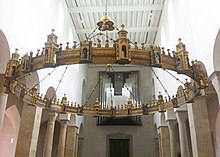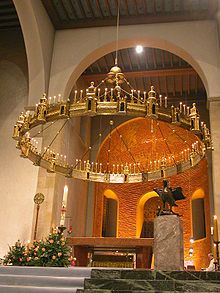Hezilochandel
The Hezilo chandelier is a Romanesque chandelier in the Hildesheim Cathedral . It was donated by Bishop Hezilo (1054-1079). The program of images and inscriptions probably also came from Hezilo. Romanesque only three more are in Germany chandelier get: The older azelin chandelier (also called Azelinleuchter), which also hangs in the Hildesheim Cathedral, the Barbarossa chandelier in Aachen Cathedral and the Hartwigleuchter in Comburger monastery church. The Hezilo chandelier is the largest among them.
During the renovation of Hildesheim Cathedral 2010-2014, the candlestick hung in the St. Godehard Basilica in Hildesheim. Since the renovation his place in the nave has been in an axial line with the Bernward door , the bronze baptismal font , the Thietmar chandelier and the Irminsula , the column in the main apse crowned with a modern choir crystal cross.
description
The basic shape of the Hezilo chandelier is a circular hoop 6 m in diameter. The ring is made of gilded copper and has Latin inscriptions on the upper and lower edge. The area in between is divided horizontally into three fields, the middle of which is convexly curved outwards. They are richly decorated with openwork foliage and tendrils . The upper edge is covered with square battlements that carry the 72 candles.
Twelve towers and twelve gates are inserted in alternating sequence into this hoop. The towers are shaped like a Greek cross with four apses (alternating round and rectangular from tower to tower), each with a doorway. Upwards, the towers each carry a narrower roof structure, which towers over the battlements of the hoop and ends in a ball point. It is possible that there were originally small statues or traffic lights in the towers.
The gates are flat, hardly higher than the hoop, and locked at the back; the suspension ropes are anchored there. Each gate is flanked by two narrow, also richly ornamented round towers and crowned with battlements and the name of an apostle . There was probably an apostle figure in the gate opening.
A large traffic light once hung from a chain in the middle .
history
Bishop Bernward (993-1022) had already donated a large chandelier for the cathedral (later also for the church of St. Michael ). After the fire in the Altfrid Cathedral, Bishop Hezilo had the old cathedral rebuilt with changes , rejecting the new cathedral plans of his predecessor Azelin , and hanging a “gold-shimmering candlestick crown” in its nave . The significance of the Bernwardin predecessor ( Vita Bernwardi c.8) has not yet been researched .
meaning
The idea of the chandelier is the image of a floating city: according to the inscription, the heavenly Jerusalem as the destination of the old and new covenants, fragrant with the fragrance of the virtues, populated by the saints, enlightened by God himself, the source of all light. The Jerusalem chandelier type is derived from the large wheel chandelier above the Golgotha of the Church of the Holy Sepulcher . Islamic elements that can be found in its ornamentation also speak for a direct reference to Jerusalem. The Hezilo chandelier was the liturgical center of the cathedral until the 19th century. Services were held under the illuminated crown. The place marked the end and destination of the great processions of the cathedral chapter on Sundays and public holidays. There are references to liturgical dance. The Hezili chandelier also acted as a legal symbol. Violations of the sovereignty of the diocese were solemnly settled under him.
inscription
As a result of the restorations in the early modern period, the sequence of the verses has changed significantly today. The founder name "Hezilo" is also written in a later script. The oldest surviving copy in a manuscript from around 1500 reads:
+ URBS EST sublimis MIRIS FABRICATA figuris
VNDIQVE PERFECTA® FIDEI COMPAGINE IVNCTA
germine VIRTVTVM QVAE MIRE SVRGIT IN ALTVM
AVCTORES OPERIS TOGA VESTIT CANDIDA PACIS
IN VIRTVTE SVA Database SOL LVCET Illa
ET SOLIVM REGNI CORDIS LOCAT IN PENETRALI
CVIVS VESTIBVLO VETVS ET NOVVS EXCVBAT ORDO
MISTICA DISCERNIT TENET ASPICIT OMNIA NOVIT
FLORIBVS HIC vivis animarum CVRIA LVCIS
ANTE DEI faciem DIVINUM spirat ODOREM
HOS PADRE eT VERBVM CIVES eT SPIRITVS HORVM
VNVS eT IPSE REGIT QVI QVOD SVNT IPSE creavit
+ MATER IVSTITIAE VIA VITAE GRATIA CVLPE
ISTIVS ORNATVS PIA VIRGO Suscipe MVNVS
ETQUE DO (et quod ?) PARS ONERIS PER TE QVOQVE PARS SIT HONORIS
DA PATER ETERNE PATRIS VNICE SPIRITVS ALME
VT PRVDENS FORTIS IVSTVS MODERAMINE MITIS
HIC SERAT ATQVE METAT QVOD LUCIS IN HORREA CEDAT
ET SPES ATQVE FIDES ET ADPESI VISEM ACTIO
REGENS
PAC IGNIS CONSVMAT ET OMNIA CARNIS
NE CAREAT PATRIA VIA LABILIS VRGEAT ISTA
SED MVNDVS CORDE SANCTVS ET IVSTVS IN ORE
SIT ODOR SPONSO SVPER OMNIA BALSAMA CHRISTO
This is the lofty city, made of wonderful figures, connected
everywhere in the perfect fabric of faith,
which soars wonderfully with the scion of virtues.
The originator of the work is dressed in the white robe of peace.
In its own virtue, the sun of the sun shines in her
and sets the throne of kingship within the heart.
In the forecourt, the old and new departments
keep watch, distinguish, keep and examine all secrets.
From living flowers of the souls a court of light breathes here
before the face of God divine fragrance.
These citizens are ruled by the Father and the Word and their spirit,
one and the same who created what they are.
Mother of Justice, Way of Life, Grace for Guilt,
Good Virgin, receive the gift of this ornament,
and what is part of the burden may through you also be part of the honor.
Eternal Father, the Father's native, give refreshing spirit,
that the wise, strong, righteous, and mild in steering
, sow here and reap what comes into the barn of light.
And hope, faith and action of love
may show him. The sight of peace gives peace.
May the consuming fire also consume everything fleshly, so
that he does not lack his home and that wavering path does not bring him into distress, but pure in heart, holy and just in speaking,
let him be a fragrance to Christ the bridegroom beyond balm.
restoration
Restoration work was carried out in the 16th, early 19th and 20th centuries. The Hezilo chandelier was dismantled and relocated during the Second World War. The Hezilo chandelier hung in the nave until the cathedral was destroyed in 1945. In 1960, after the cathedral was rebuilt, it was placed in the crossing above the high altar. The chandelier was again painstakingly restored from 2002 to 2007 and returned to its original place in the nave in 2014.
literature
- Willmuth Arenhövel: The Hezilo wheel chandelier in Hildesheim Cathedral: Contributions to Hildesheim art of the 11th century with special consideration of ornamentation. Mann, Berlin 1975, ISBN 3-7861-4099-5 .
- Norbert Bergmann: The Hezilo chandelier - a system analysis and its consequences. In: Ursula Schädler-Saub (Hrsg.): World cultural heritage Germany. Preventive conservation and conservation perspectives, international conference of the German National Committee of ICOMOS. Hildesheim, 23-25. November 2006. Regensburg 2008
- Adolf Bertram : History of the Diocese of Hildesheim. Volume I, Hildesheim 1899, p. 116f u. 120 f.
- Bernhard Gallistl: Meaning and use of the large crown of lights in the Hildesheim cathedral . In: Concilium medii aevi 12 , 2009, pp. 43-88, available online as a PDF file: cma.gbv.de (PDF; 2.9 MB), accessed on January 18, 2012.
- Bernhard Gallistl: The dance in Hildesheim Cathedral. In: Concilium medii aevi 19. 2016, pp. 53–69, available online as a PDF file: cma.gbv.de, accessed on January 18, 2016
- Ch. Wulf (Ed.): The inscriptions of the city of Hildesheim. Ges. And edit. by Ch. Wulf. Wiesbaden 2003, (The German inscriptions 58). Volume 2. pp. 213-216
Web links
- The Hezilo chandelier. Website of the Hildesheim Cathedral
- City of Hildesheim: Cathedral (DI 58). Detailed description of the wheel chandelier at Insschriften.net
- Paul Naredi-Rainer: The Hezilo chandelier in Hildesheim Cathedral and the idea of the heavenly Jerusalem. Lecture at the European Talks of the Institute for History, University of Hildesheim Foundation , 2015 (PDF)
- Joanna Olchawa: Review of Karl Bernhard Kruse (Ed.): The Hezilo chandelier in Hildesheim Cathedral. In: Sehepunkte. Vol. 15, 2015, No. 9
- The restoration of the Hezilo chandelier is entering the practical phase. Church newspaper Hildesheim ( Memento from September 27, 2007 in the web archive archive.today )
- The Hezilo chandelier in Hildesheim Cathedral. Research results on the chandelier, Ingenieurbüro Büro Bergmann, May 22, 2017
Individual evidence
- ↑ Martina Giese: The text versions of the biography of Bishop Bernwards von Hildesheim . ( MGH Studies and Texts 40), Hannover 2006, ISBN 3-7752-5700-4 , p. 114
- ↑ Bertram, p. 117
- ↑ Sabine Noack-Haley: Islamic elements on the Hezilo chandelier in the Mariendom in Hildesheim . In: Martina Müller-Wiener: Al-Andalus and Europe . Imhof, Petersberg 2004, ISBN 3-935590-77-6 , pp. 197-204.
- ↑ Gallistl, pp. 44-45; 80-81.





